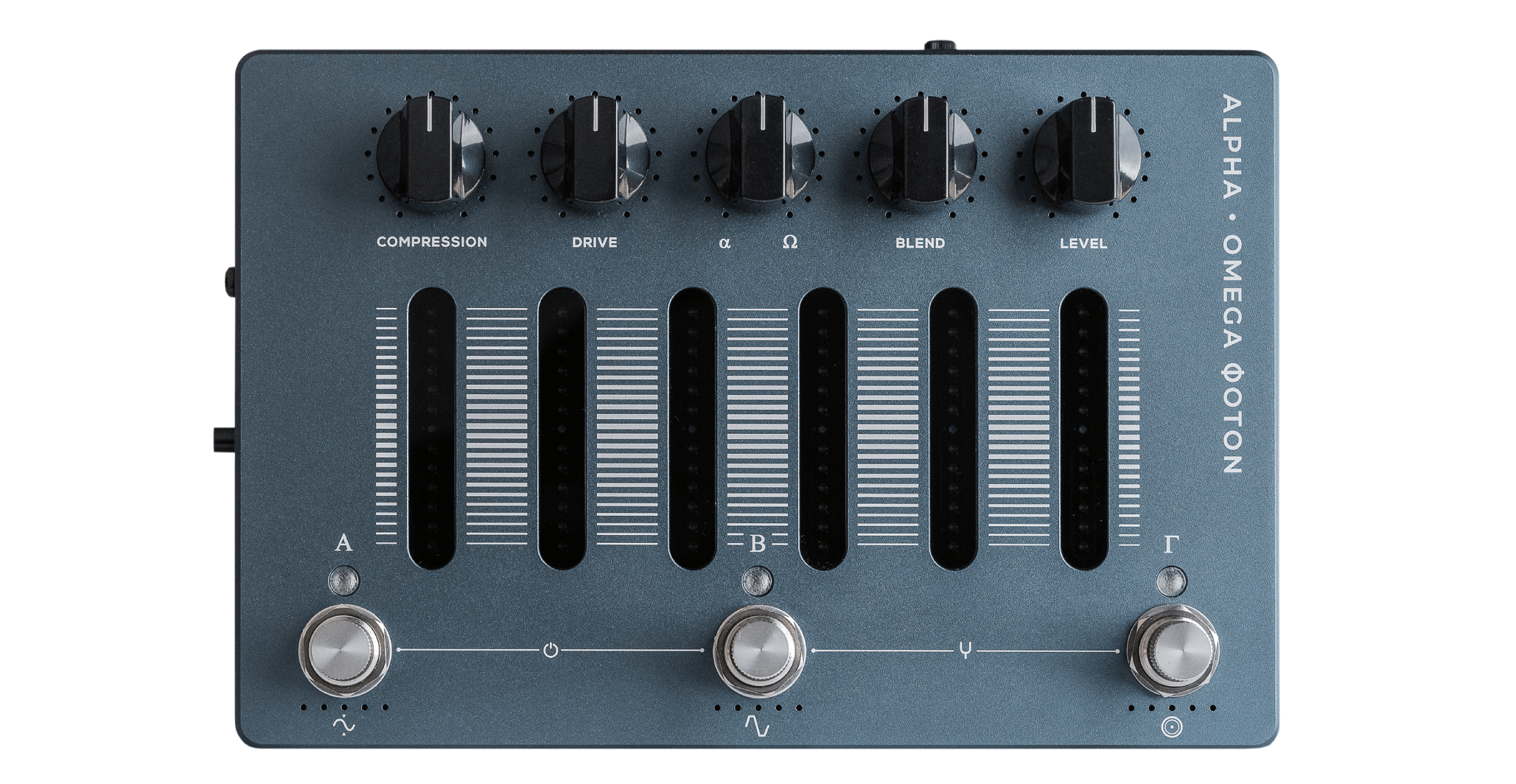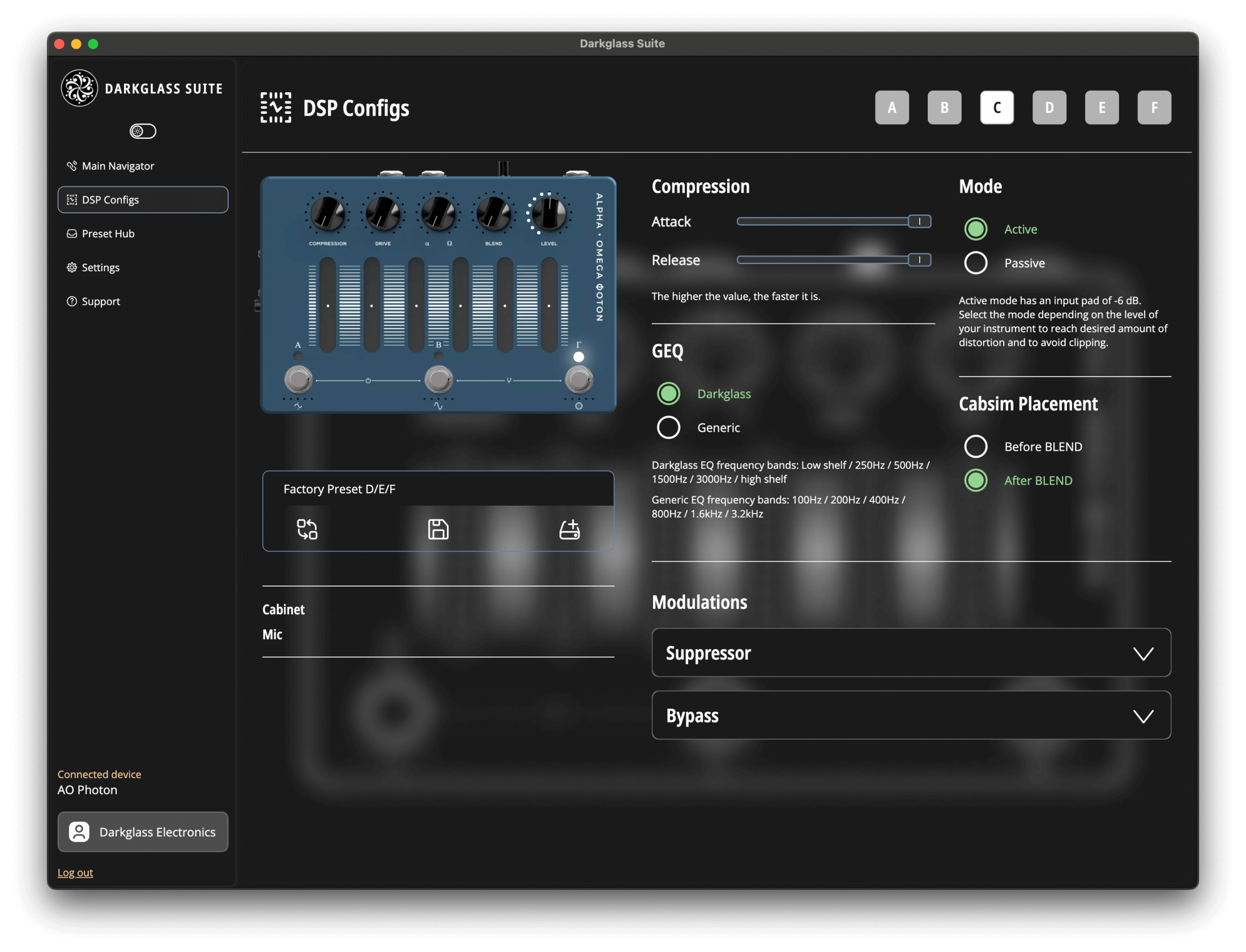
Φ
We took our Alpha·Omega, and with relentless efforts added all the learned engineering to it. Placing the iconic distortion circuit into a new paradigm enables a range of possibilities that were never before available.

The Compression potentiometer is the one-knob solution for compression on the Alpha·Omega Φoton. This controls the amount of input gain to the compressor and intelligently applies the correct amount of makeup gain so that your signal is always driven at the appropriate level, no matter how much compression is applied.
The Drive potentiometer adds distortion and drive to our signal (modes 2-4) or blends in the tube preamp emulation (mode 1). Crank this knob to add more saturation or character to your distortion/preamp part of the signal chain.
The Mod potentiometer selects or mixes between the Alpha and Omega circuits. Alpha is punchy, tight with a lot of definition, whereas Omega is simply brutal and raw.
The Blend potentiometer mixes between the distortion signal and the clean sidechain signal.
The Level potentiometer controls the master volume of the Alpha·Omega Φoton.
Each slider has a -12 dB to 12 dB range. From left to right, the frequency bands for each slider correspond to a low shelf, 250 Hz, 500 Hz, 1.5 kHz, 3 kHz, and a high shelf.
Width: 18 cm / 7″
Length: 12 cm / 4 ½”
Height: 6 cm / 2 ½”
Weight: 0,7 kg / 1,55 lb

This control allows setting the input gain of the compressor that will translate into how much the signal is compressed while our intelligent make-up gain algorithm keeps the output of the compressor at usable levels. The compressor has 5 ratios available: 4:1, 8:1, 12:1, 20:1 and ALL IN.

At the heart of the distortion circuit is an accurate model of the Alpha·Omega distortion. Carefully developed in collaboration with Jon Stockman, the Alpha·Omega offers two distinct distortions that can be blended for even further versatility. The familiar Growl and Bite boost functions are also available for adding more low end and/or high end sparkle.

The Alpha·Omega Φoton supports Impulse Response (IR) cabinet simulations and has 5 cabinet slots on board. The default IRs have been selected by the Darkglass Team. New IRs can be assigned to the 5 slots using the Darkglass Suite (desktop or mobile).
Utilizing the desktop or mobile version of the Darkglass Suite allows you to customize the settings of each preset to your liking. The signal chain options are available with the embedded noise gate, in addition with the use of the available impulse responses from our library or your custom third party impulses to the available slots.
Custom routing options for each output are available and MIDI mapping to control the extra preset slots with program change commands and control change commands for the specific available controls of your choice.

This is the primary instrument input on the Alpha·Omega Φoton. Connect your instrument or output from your pedal board to the 1/4” mono jack.
The stereo input of the Alpha·Omega Φoton enables the playback of backing tracks while practicing or recording. Connect your mobile phone, laptop etc. to the 1/8” stereo jack.
The headphone output can handle headphones with an impedance of 16 – 600 ohms. Connect your headphones to the 1/8” stereo jack and set the desired level from the dedicated potentiometer next to the jack.
An XLR output with a ground lift switch provides a reliable standard connection to a mixing desk or an external audio interface for a guaranteed low-noise signal.
A standard 1/8” TRS (Type B) jack allows connecting an external MIDI controller to the Alpha·Omega Φoton for even more flexibility.
The USB-C port unlocks the Alpha Omega Φoton’s USB audio interface capabilities and enables interaction with the Darkglass Suite desktop app, allowing for software updates and access to the Darkglass IR library, containing hundreds of cabinet simulations. USB MIDI is also supported.
The two balanced outputs add routing versatility and the option of using the Alpha·Omega Φoton as a fully equipped audio interface. Connect your studio monitors, amplifier or other effects to the 1/4” balanced jacks using a TRS connector (Tip +, Ring -, Sleeve GND). If you feed an unbalanced input from these outputs, use an instrument cable with a mono 1/4” plug.
The Alpha·Omega Φoton has a current draw of ~500mA. Only use a regulated 9V DC adapter with a center-negative plug. Unregulated power supplies and/or higher voltages may result in suboptimal noise performance and even damage your unit, voiding the warranty
In the interest of continuous improvement, specifications are subject to change without notice. If you have any questions, please don’t hesitate to contact us at www.darkglass.com
The manufacturer claims that the above product fulfills the requirements as set by EN55013, EN55020, EN60555-2, EN60555-3, RoHS, WEEE.